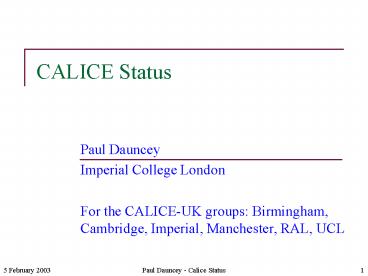CALICE Status - PowerPoint PPT Presentation
Title:
CALICE Status
Description:
... tile or digital (small cell) made with RPC's, scintillating tiles or GEM's ... 350000 1 1cm2 RPC, scintillator or GEM pads with digital readout. Timescale is short ... – PowerPoint PPT presentation
Number of Views:43
Avg rating:3.0/5.0
Title: CALICE Status
1
CALICE Status
- Paul Dauncey
- Imperial College London
- For the CALICE-UK groups Birmingham, Cambridge,
Imperial, Manchester, RAL, UCL
2
The CALICE collaboration
- Study calorimetry for a future linear collider
- Both electromagnetic (ECAL) and hadronic (HCAL)
- ECAL studies are for Si-W tracking calorimeter
- HCAL studies are for analogue scintillating tile
or digital (small cell) made with RPCs,
scintillating tiles or GEMs - Big collaboration already
- 150 people, 24 institutes, 8 countries (including
Europe, US and Asia) - DESY is a member (CALICE grew out of TESLA TDR
studies) - and still expanding
- 6 institutes have joined since the last LCUK
meeting - FNAL have also approached the collaboration
- Informal agreement on collaboration with
SLAC/Oregon - Recent summary of status written for DESY PRC in
October - Can find from CALICE-UK page http//www.hep.ph.i
mperial.ac.uk/calice/
3
CALICE beam test
- Major aim is beam test
- ECAL 20?20?20cm3
- 30 layers of tungsten
- 9720 Si diode pads with analogue readout
- HCAL 1?1?1m3
- 38 layers of iron
- 15000 5?5cm2 scintillator pads with analogue
readout, OR - 350000 1?1cm2 RPC, scintillator or GEM pads with
digital readout - Timescale is short
- mid 2004 mid 2005
4
CALICE-UK approval
- UK project (finally!) approved in Dec 2002
- Funding only for two full FYs, not the three
requested - Funds up to March 2005 cannot complete beam test
or do analysis! - Can reapply to extend in 18 months
- Equipment fund sufficient to build ECAL
electronics - We will design and build VME boards and DAQ
system for beam test - Hope to use same boards for HCAL readout
(analogue and digital) - Full effort request granted for engineering from
Rutherford Laboratory - New engineer (Adam Baird, RAL) has now joined the
project - One RA post for two years at Cambridge
- For simulation work, the other part of the UK
involvement - Travel money for the two FYs
5
CALICE-UK simulation studies
- Two sets of studies going on
- Jet resolution is major driver for fine-grained
calorimetry - Simulation indicates required 30/?E is
achievable using energy flow - but simulation needs to be verified
- Hadronic interactions known to be difficult to
model - Compare Geant3/Geant4/Fluka predictions
- Birmingham and Cambridge groups
- Beam energy spread will be significant
- Luminosity will need to be known as a function of
?s - Bhabha rate is high and (obviously) depends
directly on luminosity - Measure ?s for each event from acollinearity
angle of e and e - Could use tracker only but need very high
efficiency at low angles - UCL group
6
Geant3/Geant4 electron comparisons
- Expect EM response to be modelled well
- Use beam test configuration for studies
- Direct comparison to data when available
- Agreement is reasonable after tuning
- Low energy cut-offs
- Production of ?-rays
7
Geant3/Geant4 pion comparisons
- Did not expect hadronic response to be as good
- Pion beam agreement also pretty reasonable after
same tuning - Comparable to (better than?) electrons
8
Geant3/Geant4 proton comparisons
- Protons show much worse agreement
- Small nucleon component in all jets
- Causes almost all of small discrepancy in pion
jets - Importance of using proton test beam
- Not previously recognised
- Data may be different from both models!
9
CALICE-UK electronics work
- Effort from several groups in ECAL readout
electronics - Imperial, Manchester, UCL
- Following approval, RAL TD became involved
brought experience of CMS tracker - Significant knowledge of design of Front End
Driver (FED) - Readout board for CMS silicon tracker
- Around 500 boards needed for whole tracking
system - FED architecture close to proposed CALICE board
- Data gathering and control almost identical
- Actual data input technology very different CMS
use fibre - FED design is quite advanced
- Physical board layout complete, firmware designs
in progress - Two final-specification prototypes received two
weeks ago and currently undergoing tests - Will now use FED as a starting point
for CALICE
10
Original proposed system
- Readout board most complex part
- Each cable handled by slave FPGA
- Whole board controlled by master FPGA
- 15 readout boards
- Each handles digitisation of 2 layers
- 1 trigger board
- Holds off further triggers until readout complete
- 1 test board (not shown)
- For testing cable connections of readout board
11
FED board compared to readout board
12
FED layout
- Ideally
- Keep everything to the right
- Redo everything to the left
- FED is bigger
- More per board
- More channels per board also
- Total cost approximately the same
- Saving is on schedule and effort
13
ECAL electronics schedule
2003 2004
J F M A M J J A S O N D J F M A M
Prototype 2 boards Design
Layout
Fabrication and assembly
Testing, including VFE prototype tests
Production 9 boards Redesign
Layout
Fabrication and assembly
Testing
14
CALICE summary
- CALICE as a whole is still growing
- Dominating the LC calorimetry community
- CALICE-UK is finally approved
- Not everything we wanted (yet)
- Will keep us going for the next two years
- Simulation studies producing useful results
- Indicating the importance of proton beams
- Ensures beam test will be sensitive to most
critical issues - Electronics getting close to producing hardware
- Now based on CMS FED board cost neutral but less
effort needed - Should have prototypes this summer, final boards
early in 2004






























